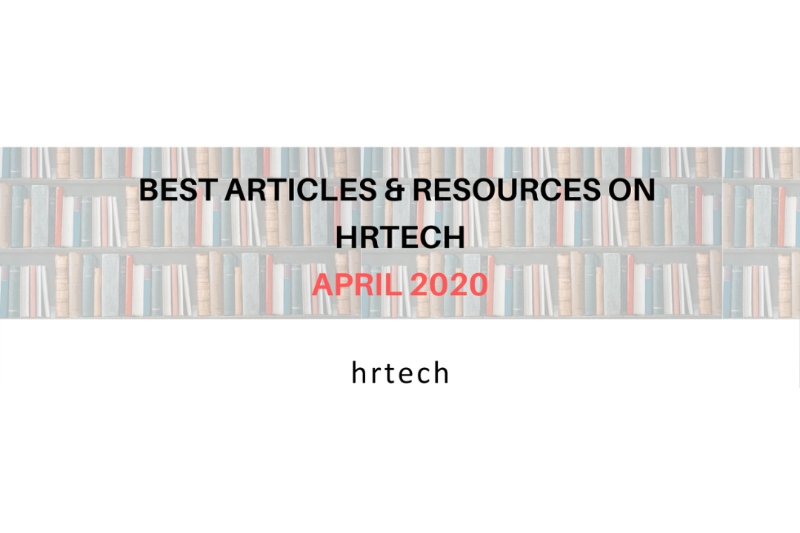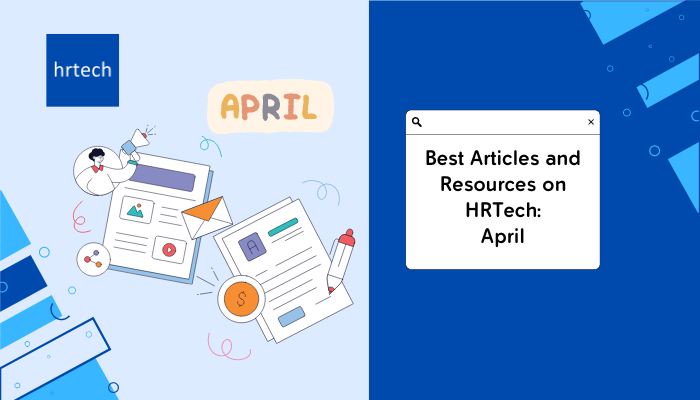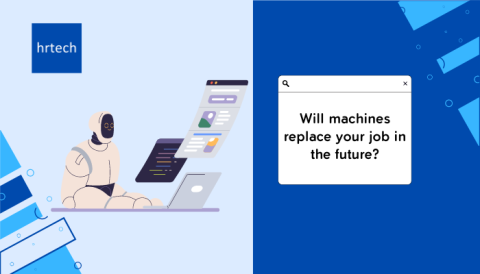Best Articles and Resources in the #HRTech space- April 2020

I. The Role of Network Analytics (ONA) in Ensuring Team Collaboration and Well Being
BY DAVID GREEN and MANISH GOEL, myhrfuture
The current Covid-19 crisis has spiked further interest in ONA (Organization Network Analysis also referred to as Relationship Analytics) as companies seek to understand the ramifications of the biggest remote working experiment in history. The article by David Green , from his discussion with Manish Goel, CEO and Co-Founder of TrustSphere, sheds light on how companies are using relationship analytics to solve challenges related to Covid-19, typical use cases organisations are facing and tips for organisations looking to get started with relationship analytics including those associated with privacy.
Fig 1: ONA – A real-time network view on how an organization is collaborating (Source: Trust Sphere)
With Organisations being pushed to adapt remote working, they are looking at key insights for their remote workforce like Are our newly remote teams collaborating enough (or too much)? What is the level of connectedness within and between teams? Who could be at risk from burnout?
As shown in Figure 1, Organisations can use relationship graph to understand meaningful patterns of engagement, collaboration and inclusiveness across teams and business units. The relationship graph produces an unbiased, empirical understanding of how an organization functions through a network (ONA) lens. Through ‘continuous listening,’ Relationship Analytics also allows companies to rapidly measure the effectiveness of the interventions they are implementing.
Read the full article here.
II. Corporate Learning In The Crisis: Microsoft Teams Coming On Strong
BY JOSH BERSIN, www.joshbersin.com
Over the last six weeks, all anyone has been talking about is COVID-19 crisis and various facets of how organizations have learnt and adapted their way out of this crisis. Corporate Learning plays a vital role in future and platforms like Zoom and Microsoft Teams play a big role in learning. Microsoft Teams not only comes strong on increasing the productivity of our teams in these crisis times but also on learning in the flow of work allowing which will become an essential activity in remote work. Teams allows integrating with content providers (like GO1) providing a single window of experience for IT admins, HR / L&D and employees.
Fig 2- Creating a seamless Learning Experience with Microsoft Teams
Learning Experience Platform (LXP) systems, designed to solve the problem of “easy to use discovery platforms” for corporate learning, will now have to focus on building a context and directed experience that helps people solve problems. These systems will either be deployed behind the Microsoft Teams or in front of Microsoft Teams, leveraging the rich features of Microsoft Teams like video transcription, topic-analysis, built-in streaming and a like. The intent will change from publishing a lot of content and providing an intelligent search on it, to capability-based content.
Read complete view on Corporate Learning In The Crisis, here.
III. Everything You Need To Know About Virtual Campus Recruiting
BY TALVIEW
Annual campus hiring events have been a logistical challenge with detailed planning by Campus recruitment teams in their workforce forecast and the concerted efforts to promote the employer brand pre and post event till the cohort is onboard.
When coronavirus forced campus closures, colleges across the globe moved towards remote learning and organisations are looking towards a different approach to campus hiring to ensure they are able to build pipelines of talent through “Virtual Campus Fairs. The article touches upon various aspects of Remote hiring including:
- What is a Virtual Career Fair?
- Remote Diversity Hiring
- Virtual Campus Recruiting and Technology
- Employer Branding at Virtual Campus Events
As virtual campus recruiting increases in popularity over the next several months and years to come, organizations and need to improve their messaging, employer branding, and even technology to cater to this new recruiting function. Using online assessment tools and gamified assessments would become mainstream to screen candidates at a virtual career fair. These tools ensure that the initial screening process is systematic and scientific, ensuring only the candidates with the required skills and competencies move forward in the hiring process. Technological tools and software can help organizations to hire the most suitable entry-level talent by using customized assessments to benchmark campus hiring. Get more information on Campus Recruiting, Remote Hiring, and Safe Hiring, explore the article here.
IV. How To Implement Gamified Recruiting For Talent Acquisition
BY PAUL KEIJZER (CEO and Co-Founder The Talent Games), Forbes
One of the driving forces behind Silicon Valley’s success is its ability to recruit the smartest, the most committed and, above all, the right people to fit its culture which has been achieved by applying science in the recruitment process. Laszlo Block, former SVP of Google, in his book Work Rules! explains how Google refined their hiring algorithm that took Google 15-25 interviews and six to nine months and brought it down to just four interviews and 47 days.
Organisations still however use gut instinct rather than science to select people. An ineffective and inherently biases screening process inadvertently results in poor candidate experience resulting in 46% of hires are being deemed as mis-hires, and 30% of hires who are at the risk to leave the company within the first three months of hiring, costing $30.5 billion per year in the U.S. alone.
These issues could be addressed using AI driven Gamified assessments that can significantly increase the effectiveness of our ability to get the best people into our organization. Gamifying the recruitment process can help you showcase your brand, and young candidates find game simulations quite fun and interactive.
More about Gamified recruitment and what to consider before opting for it in Paul’s article here.
V. 7 Important Ways that Modern Tech is Simplifying HR
BY ADDISSON SHAW, Adrian Tan Blog
Technology is becoming increasingly integrated into the world of Human Resources (HR), streamlining several key processes and areas. The HR Federation’s latest HCM Trends Report noted that global HR technology venture capital increased in 2019 threefold from the investment in 2017.
The article identifies 7 of the biggest ways in which modern technology is simplifying HR include – Time Freed Up for Strategic HR by automating basic administrative and repetitive tasks ; Smarter Recruiting by using automation and AI to quickly sort through and reach out to a vast candidate pools during high volume hiring periods; Better Performance Management through People Analytics that allows managers and executives to make important informed decisions about their teams in a more efficient way to boost productivity and employee engagement; More Diversity and Inclusion Through Analytics and AI by eliminating bias at various stages of recruitment process; Improving Compliance Efficiency by ensuring critical documents are upto date and available through cloud-based AI solutions; Supporting Employee Decision-Making by using cognitive computing and identifying employees who might be leaving through AI and data analysis .
Read the detailed article here.
VI. How Can Leaders Resolve Recruitment Challenges During COVID-19?
BY impress.ai
COVID-19 has resulted in an unpredictable situation. The real impact will come to the surface after things have settled down. Organisations will have to reassess their hiring systems and processes to take a more empathetic approach. In the process of recruiting, which has historically relied on face to face discussions, recruiters and hiring managers will have to embrace technology to connect with the candidates, reduce time on follow-ups and yet be more collaborative than before. Video conferencing tools like, Zoom or Microsoft Teams, can be used to facilitate video interviews. Virtual Assistants and Chatbots, like Impress.AI, can be leveraged to provide a structured and comprehensive screening experience. As the candidates apply to the open position, the chatbots can administer the questions and ease the remote recruitment process. If there is one thing that the current pandemic of COVID-19 has taught us, it is that the show must go on. We need to embrace this change, upskill recruiters and how technology can empower and resolve recruiter challenges.
Read more here.
VII. 2020 HR Tech Trends
BY VITALII BERDICHEVSKI ,Hackernoon
The third article in the four-part series of enlists some of the top trends in HR Tech. These trends are in-line with our observations in HRTech.sg. Like the rising need of specialists in jobs, there is an increase in the Specialization in HR tools. Niche job boards, AI-driven recruitment chatbots, tailored and market specific products are storming in HR Tech space. Conversational AI will help in automating repetitive and administrative tasks, thereby helping HR focus on core tasks, and streamline data collection.
Distributed workforce is on the rise as well. 42% of remote workers plan to work remotely more often than they currently do over the next 5 years. 80% of employees want to work from home at least part of the time. This will also impact the mode of interactions, require upskilling or re-skilling of talent, bring in need of skills that can be assessed with validity. Job board marketplaces may also need to adapt to this change and may require the ability to offer projects that lead to full time employment.
The research is divided in 4 parts:
- Performance Management Software industry research
- HR Management Software business research
- 2020 HR Tech trends
- List of top VC’s invested in HR Tech by the Categories
Read the full article and series here.
VIII. 10 Recommended HRTech Tools For Remote Working
BY hrtech.sg
Hiring, engaging and retaining a “remote workforce” is the new normal. As teams around the world move to work on remote platforms, HR departments (now more than ever) are looking at deploying HRTech applications that help them offer the right support, create a culture of trust, compassion and flexibility.
Read on to know about hrtech.sg’s 10 Recommended HRTech tools that will enable HR departments to quickly go virtual!
WEBINARS
IX. Webinar: Key to a successful HR Technology Deployment
Hosted By ESTER MARTINEZ with VIKRANT KHANNA(Alight Solutions) ON People Matters
The pace at which business breakthroughs are happening, the nature of organizations and jobs are getting re-configured, talent aspirations and experience are undergoing a tremendous shift. HR organizations will also need to be more and more adaptable to the change these break-throughs introduce. Adaptability is built on the foundation of the HR Operating Model and complimenting HR Technology. HR Tech market has been exploding and helping to accelerate the adaption process. However, it is important to deploy these HR technologies after a careful assessment.
In a virtual session conducted by People Matters, Vikrant Khanna (Partner, Alight Solutions) shared what makes a Successful HR technology deployment whilst exploring the journey that organizations have taken in order to balance deployment effectiveness, business priorities, and employee experience. He shared the 4 key stages in HR technology deployment: Planning, Evaluation, Deployment, and Realization and the various factors organisations should consider within each stage to ensure HR technology is successfully deployed. Planning will bring clarity on why a technology is being deployed, what are the goals/vision, how will they be measured is essential. Evaluation should focus on overall experience and not just technical specifications. Evaluation should also be futuristic in nature, envisaging how technology will shape in may be two years down the line, and consider total cost of ownership. Deployment stage should consider change management, system integration prior to go-live of the tools. Realization stage should measure the success of the tool deployment against the vision set during the Planning.
With right mindset, the journey of adopting new HR toolsets will make HR adaptable and improve the HR Operating Model.
Watch the webinar here.
X. Webinar: Behind HRTech Startup – X0PA.AI
Hosted By STEFANO VIRGILLI and DIANE HAwith NINA ALAG SURI ON VOX podcast
Nina Alag Suri, Founder and CEO of X0PA.AI, an AI tech startup which specializes in talent hiring and retention. X0PA AI was founded in 2017 to disrupt their own traditional search business and pivot to a SaaS based AI, ML platform. X0PA.AI is an Artificial Intelligence platform for people management that uses data analytics, machine learning, and advanced algorithms to produce valuable predictions for business leaders, managers, employees and candidates. By analyzing existing data, underlying trends, or new data from experiments, X0PA saves you tremendous time and resources to ensure that you find and retain the right people for your organization.
Nina shares her story and journey of how X0PA. AI came into being and how it is helping organisations and job seekers to overcome traditional challenges of how to make the process objective by removing biases and eliminate human error to scale the recruiting process through AI and Data science. Nina talk about how the perspective has changed over the years in the reception of AI from when she started X0PA 3 years ago.
Watch the podcast here.
XI. Webinar: ‘Staying Connected to Emerge Stronger’
Hosted By EVELYN CHOW with JEYAN NADARAJAH, ON BEEKEEPERdcHR.tech ON
DecodeHR webinar with Jeyan Nadarajah, Chief Marketing Officer of Beekeeper Communications, an award-winning and globally recognized communications tool, as they share insights on how companies can emerge stronger from COVID-19 by developing a communication plan and how organisations can leverage technology to build the right culture in these times.
Key take aways from the session include:
Why is it important to stay in close contact with employees and how a smartphone-based app like Beekeeper can help enhance your employee communications.
- Constantly reframe our understanding of what is taking place and reduce fear in the workforce
- Use the ‘reset’ button to re-focus on strengthening the trust
- Craft a communication plan that focusses on achieving shared understanding of a common purpose.
Apps such as BEEKEEPER are now in demand to ensure that the Leadership team is on the same page as the employees. Beekeeper’s employee communication platform integrates the non-desk workforce with the rest of the organization in real-time by connecting operational systems & communication channels within one secure, intuitive interface (both through mobile and desktop devices). Beekeeper also includes an intelligent analytics dashboard to help improve internal communication and streamline business processes.
Watch the webinar here.
About the author :

Swechha Mohapatra (IHRP-CP, Associate CIPD) is a Senior Consultant – Digital HR at hrtech.sg and has over 7 years of global experience in various Talent functions. She is a passionate HRTech evangelist and an avid learner who is certified Six Sigma-Green Belt with a background of MBA (Specialization in HR and IT) and Master’s in Labor Laws and Labor Welfare.





